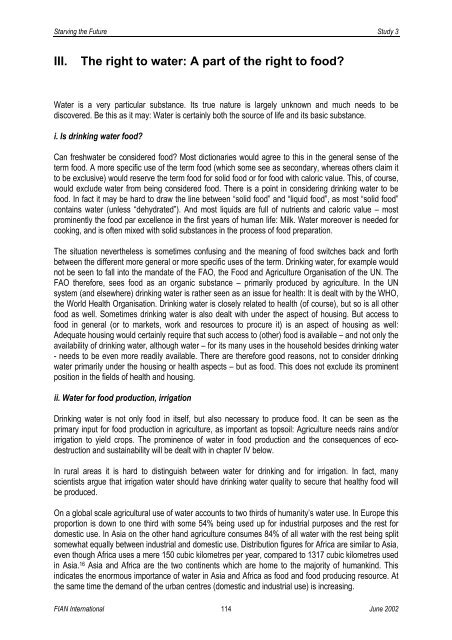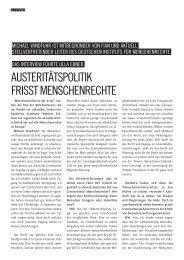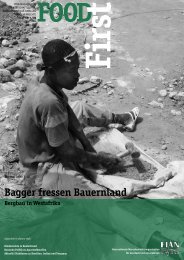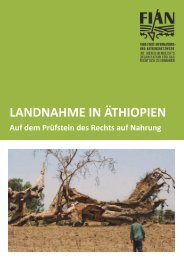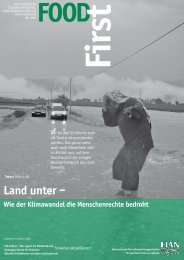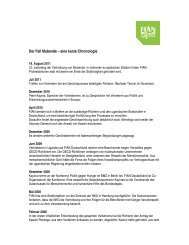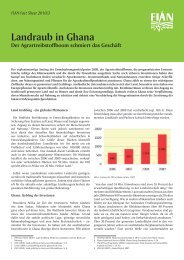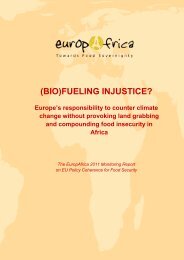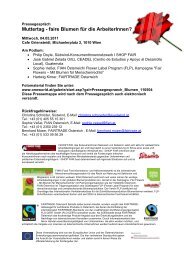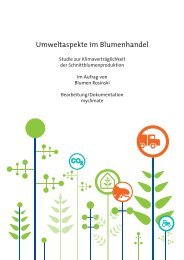Study 3: Ecodestruction and the Right to Food: The Cases of Water ...
Study 3: Ecodestruction and the Right to Food: The Cases of Water ...
Study 3: Ecodestruction and the Right to Food: The Cases of Water ...
Create successful ePaper yourself
Turn your PDF publications into a flip-book with our unique Google optimized e-Paper software.
Starving <strong>the</strong> Future <strong>Study</strong> 3<br />
III. <strong>The</strong> right <strong>to</strong> water: A part <strong>of</strong> <strong>the</strong> right <strong>to</strong> food?<br />
<strong>Water</strong> is a very particular substance. Its true nature is largely unknown <strong>and</strong> much needs <strong>to</strong> be<br />
discovered. Be this as it may: <strong>Water</strong> is certainly both <strong>the</strong> source <strong>of</strong> life <strong>and</strong> its basic substance.<br />
i. Is drinking water food?<br />
Can freshwater be considered food? Most dictionaries would agree <strong>to</strong> this in <strong>the</strong> general sense <strong>of</strong> <strong>the</strong><br />
term food. A more specific use <strong>of</strong> <strong>the</strong> term food (which some see as secondary, whereas o<strong>the</strong>rs claim it<br />
<strong>to</strong> be exclusive) would reserve <strong>the</strong> term food for solid food or for food with caloric value. This, <strong>of</strong> course,<br />
would exclude water from being considered food. <strong>The</strong>re is a point in considering drinking water <strong>to</strong> be<br />
food. In fact it may be hard <strong>to</strong> draw <strong>the</strong> line between “solid food” <strong>and</strong> “liquid food”, as most “solid food”<br />
contains water (unless “dehydrated”). And most liquids are full <strong>of</strong> nutrients <strong>and</strong> caloric value – most<br />
prominently <strong>the</strong> food par excellence in <strong>the</strong> first years <strong>of</strong> human life: Milk. <strong>Water</strong> moreover is needed for<br />
cooking, <strong>and</strong> is <strong>of</strong>ten mixed with solid substances in <strong>the</strong> process <strong>of</strong> food preparation.<br />
<strong>The</strong> situation never<strong>the</strong>less is sometimes confusing <strong>and</strong> <strong>the</strong> meaning <strong>of</strong> food switches back <strong>and</strong> forth<br />
between <strong>the</strong> different more general or more specific uses <strong>of</strong> <strong>the</strong> term. Drinking water, for example would<br />
not be seen <strong>to</strong> fall in<strong>to</strong> <strong>the</strong> m<strong>and</strong>ate <strong>of</strong> <strong>the</strong> FAO, <strong>the</strong> <strong>Food</strong> <strong>and</strong> Agriculture Organisation <strong>of</strong> <strong>the</strong> UN. <strong>The</strong><br />
FAO <strong>the</strong>refore, sees food as an organic substance – primarily produced by agriculture. In <strong>the</strong> UN<br />
system (<strong>and</strong> elsewhere) drinking water is ra<strong>the</strong>r seen as an issue for health: It is dealt with by <strong>the</strong> WHO,<br />
<strong>the</strong> World Health Organisation. Drinking water is closely related <strong>to</strong> health (<strong>of</strong> course), but so is all o<strong>the</strong>r<br />
food as well. Sometimes drinking water is also dealt with under <strong>the</strong> aspect <strong>of</strong> housing. But access <strong>to</strong><br />
food in general (or <strong>to</strong> markets, work <strong>and</strong> resources <strong>to</strong> procure it) is an aspect <strong>of</strong> housing as well:<br />
Adequate housing would certainly require that such access <strong>to</strong> (o<strong>the</strong>r) food is available – <strong>and</strong> not only <strong>the</strong><br />
availability <strong>of</strong> drinking water, although water – for its many uses in <strong>the</strong> household besides drinking water<br />
- needs <strong>to</strong> be even more readily available. <strong>The</strong>re are <strong>the</strong>refore good reasons, not <strong>to</strong> consider drinking<br />
water primarily under <strong>the</strong> housing or health aspects – but as food. This does not exclude its prominent<br />
position in <strong>the</strong> fields <strong>of</strong> health <strong>and</strong> housing.<br />
ii. <strong>Water</strong> for food production, irrigation<br />
Drinking water is not only food in itself, but also necessary <strong>to</strong> produce food. It can be seen as <strong>the</strong><br />
primary input for food production in agriculture, as important as <strong>to</strong>psoil: Agriculture needs rains <strong>and</strong>/or<br />
irrigation <strong>to</strong> yield crops. <strong>The</strong> prominence <strong>of</strong> water in food production <strong>and</strong> <strong>the</strong> consequences <strong>of</strong> ecodestruction<br />
<strong>and</strong> sustainability will be dealt with in chapter IV below.<br />
In rural areas it is hard <strong>to</strong> distinguish between water for drinking <strong>and</strong> for irrigation. In fact, many<br />
scientists argue that irrigation water should have drinking water quality <strong>to</strong> secure that healthy food will<br />
be produced.<br />
On a global scale agricultural use <strong>of</strong> water accounts <strong>to</strong> two thirds <strong>of</strong> humanity’s water use. In Europe this<br />
proportion is down <strong>to</strong> one third with some 54% being used up for industrial purposes <strong>and</strong> <strong>the</strong> rest for<br />
domestic use. In Asia on <strong>the</strong> o<strong>the</strong>r h<strong>and</strong> agriculture consumes 84% <strong>of</strong> all water with <strong>the</strong> rest being split<br />
somewhat equally between industrial <strong>and</strong> domestic use. Distribution figures for Africa are similar <strong>to</strong> Asia,<br />
even though Africa uses a mere 150 cubic kilometres per year, compared <strong>to</strong> 1317 cubic kilometres used<br />
in Asia. 16 Asia <strong>and</strong> Africa are <strong>the</strong> two continents which are home <strong>to</strong> <strong>the</strong> majority <strong>of</strong> humankind. This<br />
indicates <strong>the</strong> enormous importance <strong>of</strong> water in Asia <strong>and</strong> Africa as food <strong>and</strong> food producing resource. At<br />
<strong>the</strong> same time <strong>the</strong> dem<strong>and</strong> <strong>of</strong> <strong>the</strong> urban centres (domestic <strong>and</strong> industrial use) is increasing.<br />
FIAN International 114<br />
June 2002


